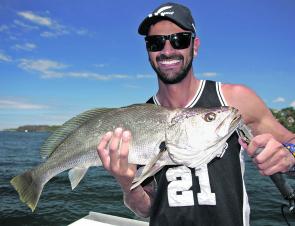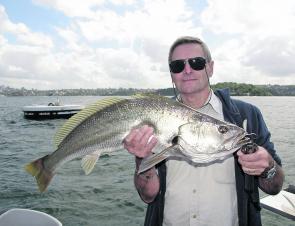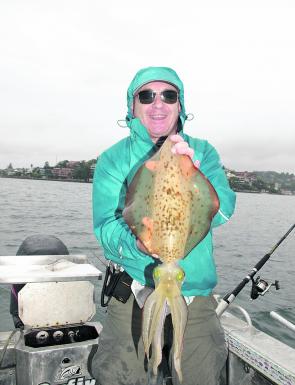The transitional period of autumn into winter has always stood out for its great flathead, mulloway and big squid fishing. Massive squid move in over the deep kelp beds for spawning and can be taken on large jigs. They are great eating, with the double whammy of being great mulloway bait.
Mulloway come on in good numbers on the tail of the return mullet run, and also to feast on the large squid. It’s the best time of year for a trophy specimen in the lower reaches on squid baits, as well as schoolies in the upper reaches on live baits such as mullet, and lures.
Likewise, great bags of flathead can be caught on lures around the boat moorings in the lower reaches, as well as big fish over the mud bottom on live baits. The upper reaches of Middle Harbour and the Parramatta River also hold some huge flatties at this time of year.
In May, the mullet come back from their coastal spawning into the rivers and estuaries. In years gone by, these mullet runs were immense. I’ve seen them in north coast creeks so thick that the water boiled from shore to shore, and if you hurled a stone in you’d kill 6. The shores were lined with dead and dying fish. For predators like big flatties and mulloway, this must have represented an abundant, easy and irresistible food source.
I’ll bet that the mulloway and big flatties traditionally followed this run.
Of course the pro fishermen have all but decimated the mullet run, but in regards to the mulloway and flatties, millions of years of evolutionary instinct would ensure that they would keep coming back for a look for a long time after the mullet had gone.
The aggression with which they hit lures is a good indication they are very much in the mood for chasing baitfish, which would be an obvious mindset for a fish who has come this far upstream for the sole purpose of getting a feed of migratory mullet. The fact that the water is only 16 degrees doesn’t seem to be a problem.
Fishing from the shore is a better option on the upper reaches. The early winter days are often very still and calm, and your approach from the bank is much less alarming that that from a boat.
If you want to catch a mulloway on a lure, I would suggest May or June, during the day, on the turn of a high or low tide, work the last 4 deep holes in the system (15’ plus) and watch for mullet. Fogs are a good indicator, as is a high pressure system. Once you find the fish, don’t move; they tend to hold in big schools.
Flathead spend most of their lives buried up to their eyes in sand or mud. To their prey they are virtually undetectable, and when you combine this with a cavernous, needle-lined mouth and lightning fast reflexes, you come up with what could possibly be the ultimate piscatorial predator. This makes them very susceptible to lure fishing.
Most lure fishing for flatties is done in 3-15’ of water. Trolling is an option, but the most fun is to be had by casting around the shallow sandbanks and weed beds. A lot of this type of fishing is visual, and in shallow water, on lures, the flattie’s reputation as a poor fighting fish goes out the window.
There are 3 main types of lure that I carry when I chase flatties — stickbaits, soft plastic/jighead combinations, and diving minnows.
To work the weed beds, there is no better lure than the soft plastic stickbait. With the hook point lying flush with the lure, they are virtually weedproof and can be effectively worked over, around and even through the weed. To fish the dropoffs and deeper channels, soft plastic/jighead combinations are my first choice. The old twin tail Mister Twister in orange or pink is legendary. The main advantage of this type of lure is its ability to be bounced along the bottom, regardless of water depth. This means it can be worked down a dropoff or along a channel bed, meaning that it spends longer in the target species’ strike zone.
Finally, for trolling you will need to carry lures that can be relied upon to maintain a specific depth. Trolling is used to prospect the more featureless areas like over the tops of sand or mud banks at high tide, and along the channels at low. These areas are usually a fairly constant depth and can be covered more extensively by trolling a lure a foot or 2 above the bottom.
If you want big flatties in the lower reaches, use big live baits. Look for the heavy concentrations of baitfish that occur around some of the deep water (40-60’) channel markers and buoys over a mud bottom. The big fish can be quite concentrated in this situation, so remember to limit your catch of the large female breeders.
Reads: 2497
School mulloway have been around in good numbers.

School mulloway have been around in good numbers.

School mulloway have been around in good numbers.

Early winter is a good time for big flathead.

Huge squid move in over the deep kelp beds in June.




